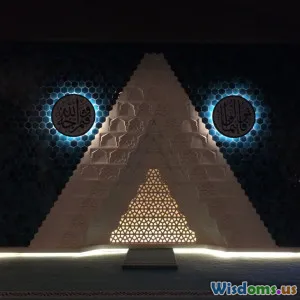
How to Use Sacred Geometry in Everyday Meditation
9 min read Discover how sacred geometry enhances meditation practices by fostering focus, spiritual connection, and inner harmony in everyday life. (0 Reviews)
How to Use Sacred Geometry in Everyday Meditation
Introduction: The Intersection of Geometry and Mindfulness
Imagine a meditation practice that not only calms your mind but also connects you to the profound patterns that underlie the universe. Sacred geometry, the study of universal geometric patterns that are believed to hold spiritual significance, offers a remarkable pathway to enrich everyday meditation. From the Flower of Life to the Sri Yantra, these shapes aren't just visually captivating—they act as energetic blueprints resonating with the harmony of creation itself.
But how can these ancient designs be meaningfully integrated into modern meditation routines? This article explores practical methods, scientific insights, and spiritual perspectives, illuminating how you can harness sacred geometry to expand your meditation experience.
What Is Sacred Geometry?
Sacred geometry refers to geometric shapes and patterns that have symbolic and sacred meanings across numerous ancient civilizations. These forms—circles, triangles, spirals, and polygons—appear in architecture, art, and nature, implying an inherent order to the universe.
Historical Context
Historically, cultures such as ancient Egypt, the Greeks, early Christians, and Hindu and Buddhist traditions incorporated sacred geometry in their temples, art, and rituals. The Great Pyramid of Giza, for example, integrates the Golden Ratio, while mandalas and yantras in Hinduism and Buddhism use symbolic geometry for meditation aid.
Modern Relevance
Today, sacred geometry sees a resurgence as a tool for mindfulness, meditation, and holistic health. Psychologists recognize the calming effects of symmetrical and repetitive patterns on the nervous system, which is key to meditation.
Why Integrate Sacred Geometry Into Meditation?
Meditation fundamentally aims to foster mindfulness, focus, and inner stillness. Sacred geometry can deepen this experience through:
Enhancing Focus and Concentration
The intricate balance of geometric shapes captures the mind's attention, reducing wandering thoughts. A study published in the Journal of Psychology and the Behavioral Sciences (2019) found that gaze fixation on symmetrical patterns enhances cognitive focus.
Facilitating Energetic Alignment
Practitioners believe that sacred geometric forms align human energy fields (chakras, auras) with cosmic energies, leading to a harmonious state conducive to deeper meditation.
Stimulating Spiritual Awareness
By meditating on sacred geometry, individuals report an intensified sense of interconnectedness and transcendence, echoing ancient insights on the universe's fractal nature.
How to Use Sacred Geometry in Everyday Meditation
1. Selecting Your Sacred Geometry Symbol
Start with a symbol that resonates with you. Popular forms include:
- Flower of Life: Represents creation and interconnectedness.
- Metatron’s Cube: Symbolizes unity and balance.
- Sri Yantra: Focuses on spiritual awakening and intention.
- The Golden Spiral: Embodies growth and the Fibonacci sequence found in nature.
Use books, apps, or websites to familiarize yourself with these symbols.
2. Visualization Techniques
Close your eyes and visualize the shape in as much detail as possible. Imagine its lines and curves glowing with light, filling your mental space.
This visualization anchors your awareness, helping reduce distractions during meditation.
Example: Visualizing the Flower of Life layer by layer can create a feeling of expanding consciousness and peace.
3. Using Physical Representations
Incorporate physical representations of sacred geometry:
- Place a printed mandala or yantra in your meditation space.
- Wear jewelry featuring sacred geometric patterns.
- Use geometric crystal grids to amplify energy.
Focusing on these objects during meditation can provide tactile and visual cues to deepen your practice.
4. Guided Sacred Geometry Meditations
Several apps and online resources offer guided meditations incorporating sacred geometry, sometimes paired with sound frequencies like Solfeggio tones.
For instance, practicing a 15-minute meditation guided through the Sri Yantra can lead to mental clarity and emotional balance.
5. Breathing with Geometry
Synchronize your breath with imagined geometric movement—for example, tracing the paths of a hexagon or spiral with your imagination as you inhale and exhale. This method combines breathwork with focused meditation, enhancing calmness.
Scientific Insights into Sacred Geometry and Meditation
Although sacred geometry's spiritual claims are challenging to quantify, several scientific findings offer supportive insights:
Neurological Effects
Studies using neuroimaging indicate that focusing on symmetrical and repetitive visual stimuli can activate the brain’s default mode network (DMN), associated with self-awareness and introspection during meditation.
Pattern Recognition and Relaxation
Humans are naturally wired to recognize patterns. Engaging the brain’s pattern recognition modules via sacred geometry can facilitate cognitive ease, reducing stress and anxiety.
The Role of Symmetry
Research in environmental psychology (Kellert & Wilson, 1993) shows symmetrical environments promote well-being, a principle that applies to sacred geometry's harmonic forms in meditation spaces.
Real-World Examples: Meditation Practices Using Sacred Geometry
Maharishi Mahesh Yogi and Yantras
The founder of Transcendental Meditation emphasized mantra and symbolic focus, often incorporating yantras as vehicles for concentration and spiritual awakening.
Crystal Healing and Geometry
Crystal therapists frequently arrange stones in sacred geometric patterns to enhance vibrational energy during guided meditations.
Yoga and Mandalas
Many yoga practitioners integrate mandalas with breathing exercises to deepen concentration and unlock subtle energy centers.
Tips for Beginners
- Start Simple: Choose one geometric shape and focus on its visual or symbolic qualities.
- Consistency Is Key: Incorporate sacred geometry symbols daily for 10-20 minutes.
- Create a Calm Environment: Enhance your meditation space with natural light and quiet surroundings.
- Combine with Other Practices: Use affirmations, breathwork, or sound therapy alongside geometry.
- Be Patient: Like meditation itself, benefits deepen over time.
Conclusion: Unlocking Universal Harmony Through Sacred Geometry
Sacred geometry offers more than beautiful patterns—it opens a gateway to aligning the mind, body, and spirit with the universe's foundational rhythms. As you incorporate these geometric symbols into your meditation, you foster sharper focus, heightened spiritual insight, and a tranquil heart.
Integrating sacred geometry into everyday meditation transforms a simple sit-down into a profound journey of connection and harmony. Whether through visualization, physical symbols, or guided sessions, these universal patterns act as energetic compasses pointing you inward to peace and enlightenment.
Begin your exploration of sacred geometry in meditation today, and discover the unfolding tapestry of ancient wisdom woven seamlessly into your modern mindfulness practice.
References:
- Kellert, S. R., & Wilson, E. O. (1993). The Biophilia Hypothesis.
- The Journal of Psychology and the Behavioral Sciences, 2019 (Symmetry and Focus Study).
- Maharishi Mahesh Yogi Archives.
- Scientific American on Pattern Recognition and Human Cognition.
Images and External Resources:
- Explore interactive Flower of Life generators online.
- Download guided Sri Yantra meditations on popular mindfulness apps.
- Visit local museums featuring sacred geometry art for deeper inspiration.
Embark on your geometric meditation journey today and harmonize with the universe’s eternal pulse.
Rate the Post
User Reviews
Popular Posts

















